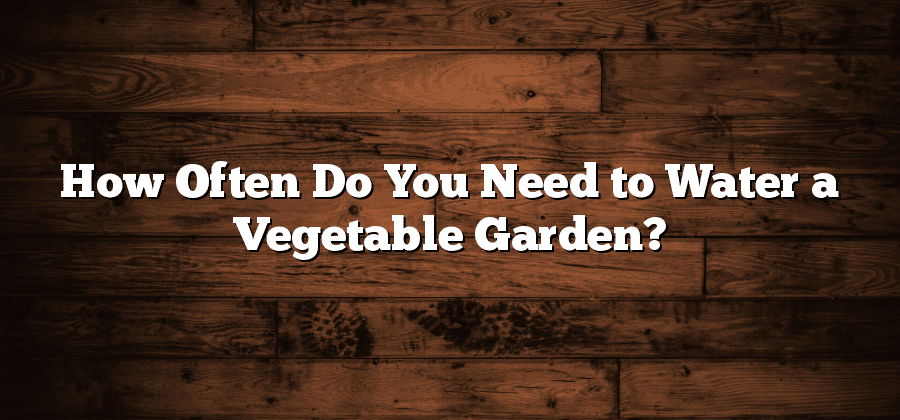Factors Affecting Vegetable Garden Watering
When it comes to watering your vegetable garden, there are several factors that can affect how often and how much water your plants need. One of the most important factors to consider is the type of soil in your garden. Different soil types have varying levels of water retention and drainage, which can directly impact the watering needs of your vegetables. Sandy soil, for example, tends to drain water quickly, requiring more frequent watering sessions, while clay soil retains water for longer periods, necessitating less frequent watering.
Another factor to take into account is the weather conditions in your area. Hot and dry climates will naturally have higher water requirements for vegetable gardens compared to cooler and more humid regions. In addition, the time of year and the stage of growth of your plants can also influence watering needs. Newly planted seedlings and young plants generally require more frequent watering to establish their roots, while mature plants may need less frequent watering once they are well-established. By considering these factors, you can ensure that your vegetable garden receives the proper amount of water for healthy growth.
Understanding Your Vegetable Garden’s Water Needs
Understanding Your Vegetable Garden’s Water Needs:
To maintain a thriving vegetable garden, it is crucial to understand the water needs of your plants. Each vegetable variety has unique requirements, and factors such as climate, soil type, and stage of growth can further influence their water needs. Regardless of the specific factors, however, proper watering techniques are essential for healthy plant development and bountiful harvests.
One important aspect to consider is the rate of evaporation in your garden. In hot and arid climates, water can quickly evaporate from the soil, leaving plants susceptible to dehydration. It is crucial to monitor moisture levels regularly and adjust watering accordingly. Additionally, factors such as wind exposure and shelter can also impact the rate of evaporation, further emphasizing the need for attentiveness in watering practices. By understanding and addressing your vegetable garden’s water needs, you can ensure optimal growth and maximize your garden’s yield.
• Different vegetable varieties have unique water requirements
• Factors such as climate, soil type, and growth stage affect water needs
• Proper watering techniques are crucial for healthy plant development and abundant harvests
• Monitoring moisture levels regularly is important in hot and arid climates
• Adjust watering practices based on the rate of evaporation from the soil
• Consider factors like wind exposure and shelter that can impact evaporation rate
Signs of Underwatering in a Vegetable Garden
Depriving your vegetable garden of adequate water can lead to detrimental effects on its health and productivity. Understanding the signs of underwatering is crucial for any gardener, as it allows for prompt action to be taken. One of the most telling signs is when the soil in your garden becomes extremely dry and begins to crack. This occurs because the plants are not receiving enough moisture to sustain their growth and maintain their nutritional intake. If you notice these cracks in the soil, it is a clear indication that your vegetable garden is not receiving sufficient water.
Another sign of underwatering can be observed through the leaves of your plants. When deprived of water, the leaves may start to wilt, curl, or become yellow and parched. This occurs as a defense mechanism, as the plant tries to conserve water by reducing its leaf surface area. In severe cases of underwatering, the leaves may even start to turn brown and crisp. These visual cues are your garden’s way of communicating its water needs to you. Properly identifying and addressing signs of underwatering will ensure the overall health and vitality of your vegetable garden, allowing it to flourish and yield a bountiful harvest.
Signs of Overwatering in a Vegetable Garden
Excessive watering can have detrimental effects on your vegetable garden. It’s essential to recognize the signs of overwatering to prevent further damage and ensure the health of your plants. One common indication of overwatering is the presence of yellowing or wilting leaves. When the roots of your vegetable plants are constantly submerged in water, they struggle to access vital oxygen, resulting in poor nutrient uptake and weak, discolored foliage. Additionally, if you notice a relentless dampness in the soil, even a few days after rainfall or watering, it may indicate excessive moisture accumulation. This can disrupt the delicate balance of nutrients in the soil and promote the growth of harmful fungi or bacteria, compromising the overall vitality of your garden.
The Role of Soil Type in Vegetable Garden Watering
Different types of soil have varying water-holding capacities. This plays a crucial role in determining the watering needs of a vegetable garden. Sandy soil, for example, is more porous and drains water quickly, resulting in rapid moisture loss. This means that vegetable gardens with sandy soil require more frequent watering sessions to ensure that the plants receive an adequate water supply. On the other hand, clay soil has a higher water retention capacity, holding onto moisture for longer periods. While this can be advantageous in preventing dehydration during dry spells, overwatering can quickly become a problem, leading to root rot and other issues.
Understanding the soil type of your vegetable garden is essential for effective watering. Conducting a simple soil test can help determine the composition of your soil and guide your watering practices accordingly. Soil amendments, such as adding organic matter to sandy soil or improving drainage for clay soil, can also be beneficial in creating a more favorable environment for your vegetable plants. By taking into account the role of soil type in vegetable garden watering, you can ensure optimal moisture levels and promote healthy growth and yield for your vegetable garden.






